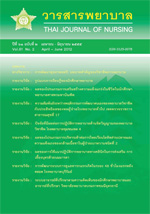ผลของการใช้แนวปฏิบัติการพยาบาลทางคลินิกในการส่งเสริมการเลี้ยงบุตรด้วยนมมารดา
Main Article Content
Abstract
การวิจัยกึ่งทดลองนี้มีวัตถุประสงค์เพื่อเปรียบเทียบ ความแตกต่างของการเลี้ยงบุตรด้วยนมมารดาในมารดา ที่ได้รับการใช้แนวปฎิบัติการพยาบาลทางคลินิกในการ ส่งเสริมการเลี้ยงบุตรด้วยนมมารดา กับมารดาที่ได้รับการ พยาบาลตามปกติ กลุ่มตัวอย่างคือมารดาและทารก แรกเกิดในหอผู้ป่วยสูติกรรมของโรงพยาบาลรามาธิบดี จำนวน 500 ราย เลือกตัวอย่างแบบเจาะจง กลุ่มเปรียบเทียบ ได้รับการพยาบาลตามปกติ ส่วนกลุ่มทดลองได้รับ การพยาบาลโดยใช้แนวปฎิบัติการพยาบาลทางคลินิก ในการส่งเสริมการเลี้ยงบุตรด้วยนมมารดา เครื่องมือวิจัย คือแบบประเมินลักษณะส่วนบุคคลและปัญหาของการให้ นมมารดา และแนวปฎิบัติการพยาบาลทางคลินิกในการ ส่งเสริมการเลี้ยงบุตรด้วยนมมารดา วิเคราะห์ข้อมูลโดยใช้สถิติพรรณนา Chi-square test และ Fisher's exact test
ผลการวิจัยพบว่า ในระยะก่อนการจำหน่าย หลังคลอด 2, 4 และ 6 เดือน กลุ่มทดลองมีการเลี้ยงบุตร ด้วยนมมารดาอย่างเดียว ร้อยละ 90.0, 69.6, 42.4 และ 3.6 ตามลำดับ ส่วนกลุ่มเปรียบเทียบมีการเลี้ยงบุตรด้วย นมมารดาอย่างเดียวร้อยละ 75.0, 54.0, 28.0 และ 2.4 ตามลำดับ กลุ่มทดลองมีการเลี้ยงบุตรด้วยนมมารดา อย่างเดียว มากกว่ากลุ่มเปรียบเทียบในระยะก่อนการ จำหน่าย หลังคลอด 2 และ 4 เดือน และมากกว่าการ ให้นมผสมอย่างมีนัยสำคัญทางสถิติที่ ระดับ .001 ส่วน การเลี้ยงบุตรด้วยนมมารดา หลังคลอด 6 เดือนของทั้ง 2 กลุ่มไม่แตกต่างกัน
The effect of clinical nursing practice guideline on breastfeeding promotion.
Rotjananirankit, N., & Naromrum , K.
This quasi-experimental research aims to compare the differences of an exclusive breastfeeding performance between postpartum mothers receiving the clinical nursing practice guideline (CNPG) on breastfeeding promotion and those receiving conventional nursing care. The sample of 500 postpartum mothers and their normal newborns in the postpartum ward at Ramathibodi Hospital, was purposively selected. The comparative group of 250 mothers and their newborns received conventional nursing care while the experimental group of 250 mothers and their newborns received nursing care based on the CNPG on breastfeeding promotion. Research tools were personal characteristics assessment and the CNPG on breastfeeding promotion . Chi-square test and Fisher's exact test were used in data analysis.
The results showed that during the periods of before hospital discharge, 2, 4, and 6 months after delivery, breastfeedings were performed in 90, 69.6, 42.4 and 3.6 percents of postpartum mothers in the experimental group and in 75, 54, 28, and 2.4 percents of postpartum mothers in the comparative group. Mothers in the experimental group significantly used breastfeedings more than those in the comparative group and more than bottle feedings during the peroids of before hospital discharge, 2 and 4 months after delivery at p<.001. There was no significantly difference in breastfeeding practice between the two groups during the period of 6 months after delivery

